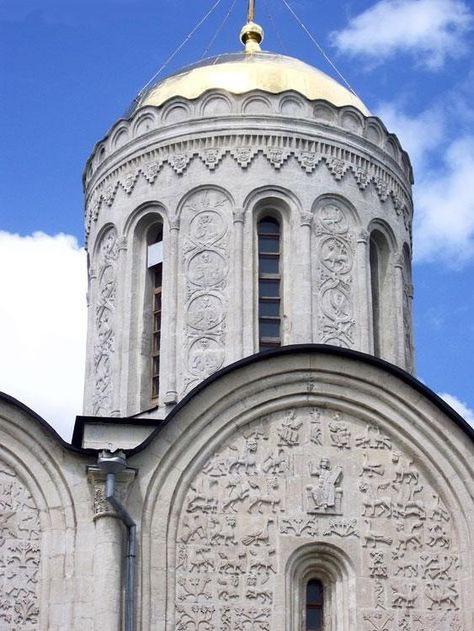The city of Vladimir is a place where Russian people are proud of their ancestors, who created magnificent architectural monuments many centuries ago, and today striking with the perfection of their shapes and the beauty of the interior. Many of them are recognized as World Heritage Sites. Among them is the magnificent court Dmitrovsky Cathedral in Vladimir, whose facade is decorated with elaborate carvings. This building is also famous for its frescoes, and it is often called a white-stone poem.
Dmitrov Cathedral in Vladimir: history
As you know, in the 13th century the Vladimir-Suzdal principality reached its highest peak, and its ruler Vsevolod decided to build a “personal” temple for his large family and close ones. I must say that in those days, there was a custom according to which the princes, in addition to the Christian name, were assigned another, by which they signed their decrees. Since Vsevolod, nicknamed for the large Big Nest, was baptized in honor of St. Dmitry Solunsky, he decided to dedicate this new church to his heavenly patron. Concerning the bookmark time of this building, there are different opinions. In particular, for many years it was believed that the construction of the Dmitrov Cathedral in Vladimir supposedly continued from 1194 to 1197, however, in the late 90s of the last century, chronicles were found that it began in 1191.
Dmitrov Cathedral in Vladimir: photos and description
In architectural terms, the temple is a one-domed, four-pillar and three-apse temple. Initially, it was surrounded by rather long galleries with stair towers, through which it connected to the princely palace. Thus, the family of the prince and the courtiers could get services directly from their chambers. Unfortunately, during the restoration work carried out in 1837 by order of Nicholas I, these auxiliary structures were dismantled, so today they can not be seen. In general, it must be said that these so-called restoration works almost became the cause of its complete destruction. Therefore, the fact that the Dmitrov Cathedral in Vladimir has survived to the present day is the merit of the restorers who worked here half a century later. They had to work hard to correct the mistakes of their predecessors.
Facade decoration
As already mentioned, the Dmitrov Cathedral in Vladimir is decorated with rich carvings. It is present on 600 bas-reliefs depicting biblical saints, as well as mythical and real animals. Most of these wonderful examples of ancient Russian art were preserved in their original form, and some were replaced with new ones during the restoration work.
The decoration of the northern facade deserves special mention, on which medieval woodcarvers depicted Prince Vsevolod himself with his sons. No less interesting are the images of Alexander the Great, as well as the biblical king David and Samson. This choice of plots is prompted by a desire to flatter the customer, who is compared with these most famous characters of antiquity.
Interior decoration
Dmitrov Cathedral in Vladimir, whose photo is often decorated with tourist avenues offering a trip along the Golden Ring route, does not differ in chic interiors. The reason again is the unfair work of restorers. However, several frescoes dating back to the 13th century are still preserved to this day. In particular, in the temple you can see fragments of the large composition “The Last Judgment”, the author of which is supposedly the artist invited by Vsevolod from Greece.
Relics
Saint Dmitry was revered by Christians as the patron saint of warriors. In his life, it is indicated that he held the position of proconsul in the city of Thessaloniki, which the inhabitants of ancient Rus called Solunya. Upon learning that Dmitry is a Christian, the emperor Galerius throws him in prison, and then orders to stab with spears. The body of the martyr is given to wild animals for devouring, but they do not touch him. Later, the Christians of the city betray the remains of the holy land. Years later, Emperor Constantine arrives in Thessaloniki and at the site of the execution of Dmitry founds a church in which the relics of the saint are stored today.

So, having consecrated his Dmitrov Cathedral in Vladimir (the description is presented above), Prince Vsevolod went in the footsteps of Constantine and brought for this church some relics from the Thessaloniki temple. They became an icon depicting the Great Martyr of Solun, written on his tombstone, and a piece of clothing on which there were drops of blood of a saint.
Assumption Cathedral
Talking about the Dmitrov Cathedral in Vladimir, one can not help but say a few words about another masterpiece of ancient Russian architecture, located just a few meters away. We are talking about the Assumption Cathedral, which is more than 850 years old. It is considered the standard of church architecture, and features of its appearance are visible in hundreds of churches built in Russia over the centuries.
This building is also included in the list of UNESCO World Heritage Sites and is considered one of the main tourist
attractions of Vladimir. Although the most beautiful, in terms of external decor, is Dmitrovsky. Assumption Cathedral, of course, leads if interiors are considered. The main pride of the temple is the magnificent frescoes of the great icon painter Andrei Rublev.
In addition, there are several niche archosols where the most prominent representatives of the Vladimir nobility and church hierarchs were buried.
The modern appearance of the Assumption Cathedral, which is familiar to everyone from the photographs, is quite different from the original one, since in 1186-1189 it was radically rebuilt, since it no longer accommodated everyone. In particular, galleries were attached to it from two sides, and four new chapters were erected at the corners.
Now you know when and by whom the cathedrals of Vladimir - Assumption and Dmitrovsky - were built, which are rightfully considered the best examples of Russian architecture.